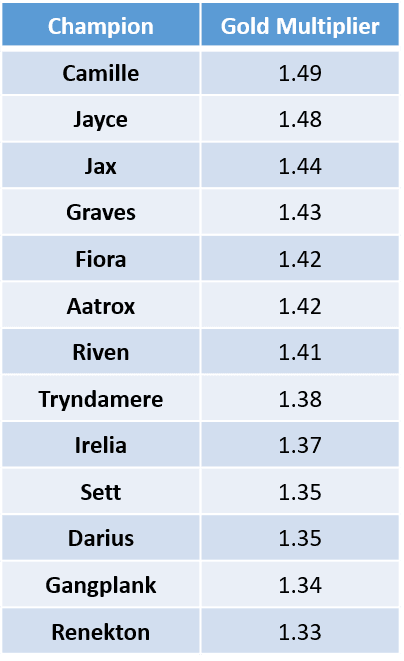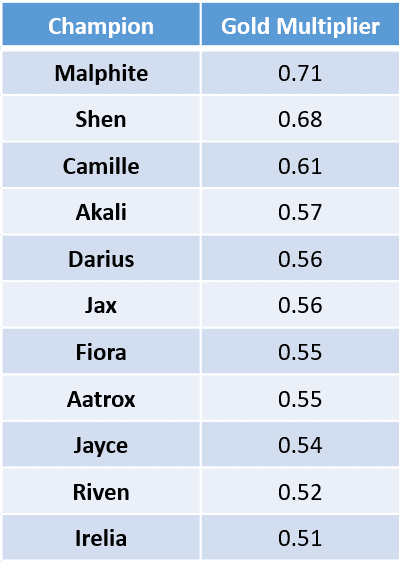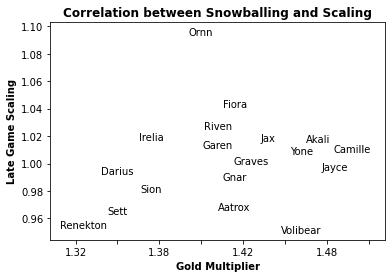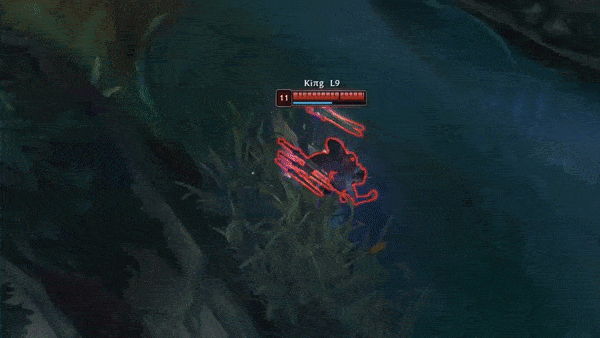LoL: How Gold Statistics can be used, and misused — An Evaluation of LEC Top Laners (Spring 2022)
A statistical analysis of Top Laners for the League of Legend’s esports league: the LEC, and who you should draft if you had a choice!
Let me ask you a question…
Imagine you’ve just loaded into the last game of your Platinum promotional series and your team decides to group together, just in case the enemy invades.
You’ve read them like a book. They head into your jungle to meet their demise. You clean ace them, with your Top laner securing a Penta Kill. He returns to base with 1600 Gold to spend.
The question is, if you could choose which Champion your Top laner was playing — who would it be? Ignore their current win rates. Take a second and actually think about it.
But why that Champion over any other? Does it really make a difference, isn’t 1600 Gold going to be just as effective on anyone?
Today, we’re talking about a metric that I call “The Gold Multiplier”, but from my example above you may prefer the term “Snowballatility” (or not, depending on how much you like to abuse the English language).
The simple explanation is: how does Gold impact a Champions win rate?
Mathematically, we calculate it like so:
Here’s a look at some values* from Top laners:

The Gold Multiplier metric for Top laners who are ahead > Note: All data is from patch 12.6, Diamond 2+ games from EUW, NA & KR. Minimum 1,500 games per Champion shown.
What surprised me when I first did this exercise was Renekton being the lowest. I thought he was a snowballing Champion? Get him ahead and win the game, right?
We have to differentiate the probability of a Champion getting ahead from its effect. Let’s take an ADC example for this one. Imagine Draven and Twitch. Who is the most likely to snowball? Draven. Who would be more likely to carry a game with a level 1 penta? Twitch.
It’s the same for Renekton, he has all the tools to get ahead but that doesn’t mean he’s the best when he’s there.
If you watch any amount of professional play, you’ve probably heard the term “eco(n)” before. It’s short for “economic” and it refers to how well a Champion or player performs with low resources. Or in other words, it’s the antithesis of snowballing. Antisnowballatility, if you like.
We can calculate it in a similar way, except rather than looking at all the games where a player is in the top 33% of Gold @ 10, we look at the bottom 33%.
In English: How does being behind in Gold impact win rate? Imagine the example from the beginning of this article, except this time it’s the enemy Top laner who gets the penta kill. Who do you want facing them?

The Gold Multiplier metric for Top laners who are behind
Malphite is a mountain, an immovable object. He’s going to be tough to kill. Even if you do, his ultimate ability still provides huge value in team fights. The same goes for Shen.
Irelia and Riven? They’re duelists. They go in, zip around, deal huge amounts of damage, flash their level 7 mastery and type “gg ez” in all chat. They offer nothing else. This playstyle doesn’t work so well if they’re considerably behind.
Whilst looking at this, a question occurred to me. Isn’t a Champions Gold Multiplier when ahead the same as their scaling? Think about it… it’s basically a metric to say how strong a Champion is with more Items, since that’s where the Gold goes. So, don’t Champions that scale well also snowball well?
To test this we first calculate a metric for “late game scaling” by taking all games in the top 33% of length and then comparing those win rates to the average. Again, in English: how many more games does the Champion win when the game goes late.
Now, we can compare our original Gold Multiplier statistic for when Champions are ahead, to the new scaling metric for when the game goes late.

How the Gold Multiplier metric correlates to late-game scaling
In general, there is a slight preference for “snowballers” to also be “scalers”, but it’s far from a perfect correlation.
Look at Volibear — he’s a monster when he’s ahead (1.46x) but really struggles during the late game (0.95x).
Irelia is below average with a gold lead (1.37x) but is above average past the 35 minute mark (1.02x).
Ornn is an outlier as his late-game prowess is related to his passive upgrades. Even if he got a penta kill at level 1, he still can’t unlock any new items for the team until later into the game.
Since I’m writing for The Esports Analyst Club, I should probably explain how this relates to professional play.
As an esports team you’ll spend hours discussing how best to draft against an upcoming opponent. There’s the obvious factors, like the strongest Champion in the meta, counter picks and synergies or a players personal comforts.
However, choosing a Champion with the “right” level of Gold Multiplier should also be a consideration. It’s all about identifying the play style and skill gaps across the map and exploiting these.
Do you have a famously strong top/jungle pairing who always get ahead? Are they facing the worst top laner in the league? Take Camille, Jayce or Yone, get ahead and snowball. Avoid Sion, Sett or Darius.
I have a perfect example of this, although I wouldn’t exactly call it esports. I’m a Platinum ranked player and I was playing off-role in our bi-weekly Clash tournament. The average Elo was around high Gold, but I ended up face-to-face with a Diamond I Irelia.
Luckily for me, I had this data handy and so locked in Malphite and accepted my fate. Yes, I went 30CS down but I never died.
Here’s my biggest contribution to us winning that game:

Here are some other articles that may be of interest.
A statistical analysis of Top Laners for the League of Legend’s esports league: the LEC, and who you should draft if you had a choice!
Why does a consistently high level of performance not always equate to a larger fanbase and viewership? What other factors do teams need to consider in order to become attractive to fans.
How can statistics be used to help player’s scout and draft the best possible esports team in League of Legends (LoL)? What statistics matter? To what extent can AI be used?